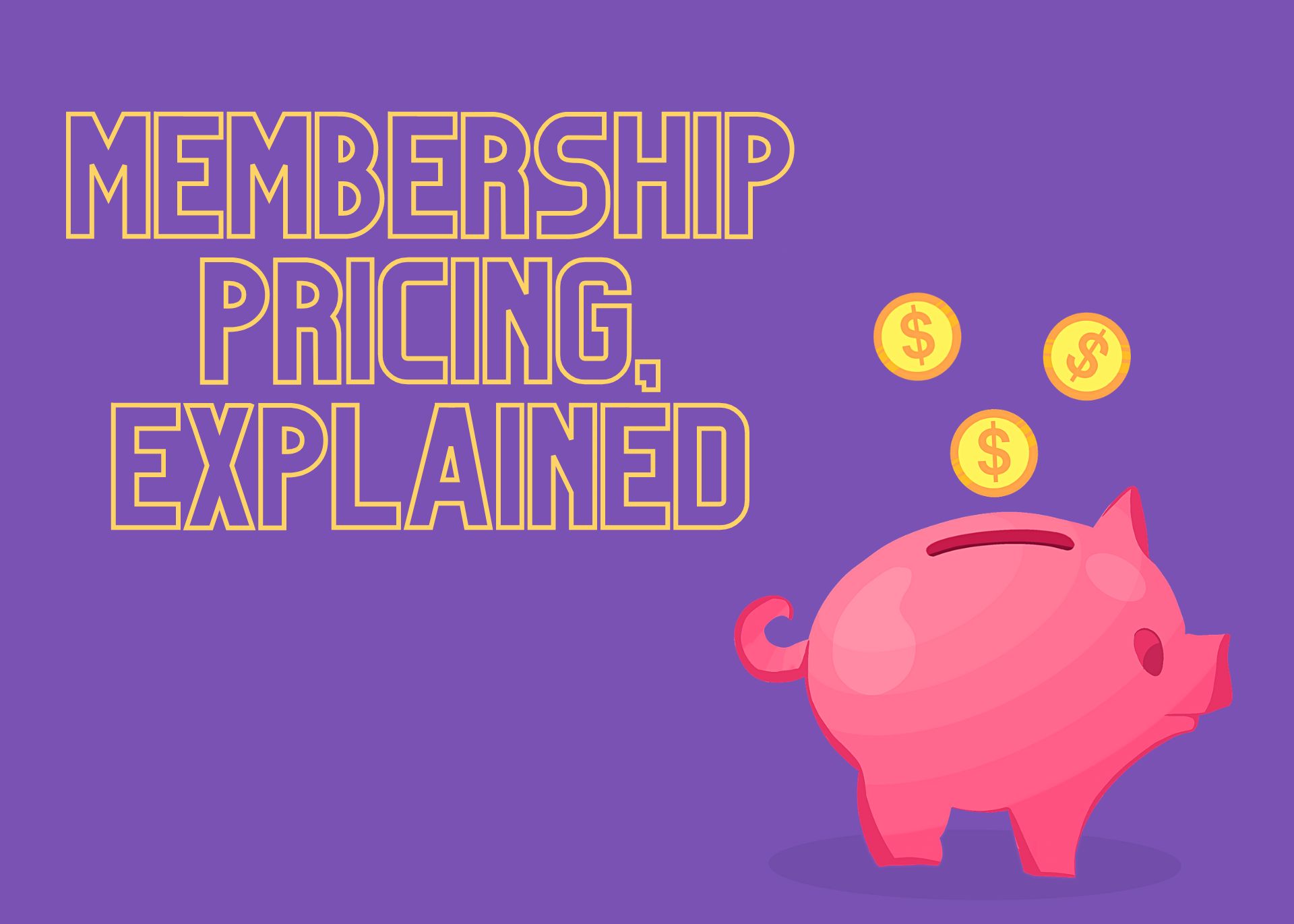Running a membership site? Congrats, then, you’re in the elite minority who’s already decided to tap into the Creator Economy and pursue financial freedom by connecting to other like-minded people. However, know that no matter how successful you may be at building communities, if membership pricing models are giving you a hard time, you’re not alone.
Pricing models can be… complicated. But we aim to untangle them and explain everything in simple terms, in this article. Read on and find out more.
Why Knowing Your Membership Pricing Model Is Crucial
This might seem pretty straightforward: you need to know how to price your membership site so you can make recurring revenue with it.
And that’s a perfectly valid way to look at it.
Allow us to present you with a different perspective too, though.
Your membership pricing model is tightly connected to the way your membership site functions and to the value it provides. A good pricing model lies at the foundation of any business, and your membership site solopreneurship adventure makes no exception from the rule. If your content is the brick-and-mortar of your entire membership site business, pricing is the glue that holds it together.
What’s more, your pricing model can make or break your business. It’s the way you monetize your site and make it profitable. If you want to keep your subscribers engaged for longer, then you need to strike the right balance between the value you provide and the money you ask in return.
Keep in mind, though: the relationship between money and value always goes both ways. If you ask a very small price, then you’ll attract a number of bargain-hunting subscribers who only care about the price, not the value. On the other hand, if you ask a huge sum for your membership site, then potential subscribers might lose interest and look elsewhere.
Membership Pricing Models to Be Aware Of
Now that we’ve established why choosing the right pricing model is important, let’s get to the nitty-gritty. Here are the top 8 most common membership pricing models to consider:
Recurrent Subscription
This is one of the most common types of membership pricing models. Essentially, it revolves around charging a set of monthly or annual fees to access your content. This type of pricing model works best for larger sites that offer a variety of topics and content.
For instance, if you’re running an online magazine with a mix of free and paid content, then this model might be the right choice for you.
Pros of using recurrent subscription:
- It provides a steady and (relatively) predictable stream of revenue.
- You can easily track the growth of your subscription base over time.
- You can adjust the price of your subscriptions based on the content you offer.
Cons of using recurrent subscription:
- Subscribers might cancel their membership if they can’t afford the monthly or annual fees.
- The initial price you set for the subscription could turn away potential customers.

Fixed-term
Fixed-term membership pricing is similar to recurrent subscription, but with one key difference: access to your content is only available for a fixed period of time. Most of the time, the content will be available for a year and then access to it will be blocked.
This type of pricing model works best for membership sites with exclusive, limited-time offers.
Pros of using fixed-term include:
- It encourages customers to purchase the membership to take advantage of the limited-time offers (which taps into the “Fear of Missing Out” many people experience when faced with limited-time discounts.)
- You can incentivize customers to purchase for a longer period of time by offering discounts for longer-term memberships.
Cons of using fixed-term include:
- You’re likely to have a hard time getting customers to re-subscribe once their membership expires.
- It’s hard to track the renewal rate of customers over time.
- You might find it hard to make people pay a large lump sump for your content, especially if you’re not a huge influencer in your niche
Front-Payment
Front-payment pricing models are based on a one-time payment for the access to your content. The idea behind it is that customers can get a lifetime access to your content in exchange for their money.
This type of member pricing is best for membership sites that offer unique, in-depth content (like online courses, eBooks and more)
Pros of using front-payment include:
- It encourages customers to purchase your content right away, which can lead to more impulse purchases.
- It’s easier for customers to understand and digest (they don’t feel like they have to commit or handle the pressure of recurring payments, for example.)
Cons of using front-payment include:
- It’s hard to get customers to commit to lifetime access when they don’t know how valuable or helpful the content might be. It’s harder to track how much money you’re making from your membership site over time
- Some customers might feel like they’re overpaying for the one-time access, which could lead to negative reviews.
Installment Payments
Installment payments are a less common membership pricing model — but still worth considering. This type of pricing model allows customers to pay for access to your content in a series of smaller payments, over time.
Installment payments are usually suitable for membership websites with expensive content that customers might not be able to afford all at once. For instance, if you are selling an online course that costs $500, offering installment payments might be the way to go.
Pros of using installment payment include:
- It encourages more customers to purchase your product because they don’t have to pay the entire amount upfront.
- It’s easier for customers to budget and plan their finances.
Cons of using installment payment include:
- It’s hard to predict your income since customers make payments at different times.
- It’s possible that some customers may default on their payments, which could lead to a loss of predicted income.
Trial-Based Pricing
Trial-based pricing is usually centered on a free period or discounted period, that allows customers to access your content for a limited time. After the trial period is over, they can decide if they want to purchase the full product or not. The “full” pricing can be recurring or a one-time fee.
This type of membership pricing model is great for membership websites that offer digital content like eBooks, online courses, etc. It tends to be particularly good for special campaigns or for membership sites just starting out and looking to earn some good reviews and social proof.
Pros of using trial-based pricing include:
- It encourages customers to try out your product before they commit to a purchase.
- It helps build trust and credibility with your customers.
Cons of using trial-based pricing include:
- It’s hard to predict how long your customers will stick around after the trial period ends.
- It could lead to more refunds, since some customers may take advantage of the free trial
- You will still have to invest in marketing efforts to reach potential customers.
Group Pricing
Group pricing models are usually used by membership websites that offer content to a wide range of customers, like corporate teams or educational institutions. This type of pricing model allows you to offer discounts on larger orders, allowing customers to save money when purchasing your content for the entire group.
Pros of using group pricing include:
- It encourages customers to purchase your content in bulk, which can lead to higher profits.
- It’s easier for customers to budget and plan their finances when they know the amount upfront.
Cons of using group pricing include:
- It’s hard to track how much money you’re making from each individual customer.
- It could lead to lower profits per sale, since customers are getting a discounted rate for buying in bulk.
Add-on Pricing Models
The add-on pricing model involves offering customers additional content or services for an extra fee. This type of pricing model is usually used by membership websites that offer subscription-based content, like monthly magazines or fitness classes.
For instance, if you run a cooking membership site and your customers pay for a course, an add-on pricing model will allow you to offer additional content like eBooks or cooking tools for an extra fee.
Pros of using add-on pricing include:
- It allows customers to customize their purchases and get access to more content when they need or want it
- It encourages customers to upgrade their membership and purchase more content, thus helping you scale your membership site business
Cons of using add-on pricing include:
- It can be difficult and expensive to develop additional content for customers.
- It can be difficult to track how much revenue you’re generating from add-ons

Donation-Based Pricing
Donation-based pricing isn’t a popular option, since most membership websites are looking to make profits. However, it can be a great way to support causes and charities that you believe in. For instance, you could create a membership site and give it your very best — in return for your effort, you could ask members to donate a small amount and contribute to the cause.
The same model can be applied to a for-profit business model too. In this case, you can ask members to pitch in whatever sum of money they want as a “thank you” for your content (e.g. think of how Patreon functions for many social media influencers.)
Pros of using donation-based pricing include:
- It allows you to support causes that you believe in
- It doesn’t feel like you’re forcing your members to pay for content
Cons of using donation-based pricing include:
- It’s hard to predict the amount of money you’ll be able to generate from donations.
- It can be difficult to come up with an incentive that’s appealing enough for customers to donate.
Membership Pricing: Conclusion
When it comes to pricing your membership site, you need to know what your goal is. Are you looking to generate as much revenue as possible? Or, are you more interested in helping causes and charities? The answer will determine which pricing model is best for you.
Whichever pricing model you choose, make sure to track your results and adjust as needed. Just because you set one pricing model, it doesn’t mean you have to be stuck with it for life if it doesn’t work. Experiment and find out which one works best for you!
You Might Also Like:
Community Membership Sites Are Thriving. Here’s How to Build Yours
How to Create the Perfect Membership Logo for Your Site
28 Digital Products to Sell for Passive Income in 2023
Build a Membership App to Maximize Your Content’s Potential & Earn More with Your Community
These WordPress Membership Site Plugins Are Amazing for Affordable, Smooth Operations
How to Choose the Membership Site Domain Name: The A to Z Guide




